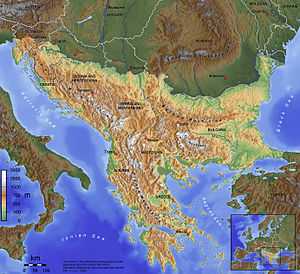Southeast Europe

Southeast Europe or Southeastern Europe is a relatively recent political designation mostly for the states of the Balkans.[1][2] Writers such as Maria Todorova and Vesna Goldsworthy have suggested the use of the term Southeastern Europe to replace the word Balkans for the region, to minimize potential misunderstandings about the term Balkans having negative connotations.[3]
Definition
The first known use of the term "Southeast Europe" was by Austrian researcher Johann Georg von Hahn (1811–1869) as a broader term than the traditional "Balkans".[4] Unlike the United Nations definitions of Eastern Europe, Western Europe, Southern Europe and Northern Europe, there are no clear and universally accepted geographical or historical divisions that delineate this region.[5] However, if United Nations definitions of bordering macroregions are done, the rest can be considered as Central Europe.[6]
Balkans model

This concept is based on a geographic argument, that is, on the boundaries of the Balkans (which is considered a synonym by the supporters). The countries located fully in the peninsula are the following: Albania, Kosovo, Bosnia and Herzegovina, Bulgaria, Greece, Macedonia, Montenegro and Serbia.[7]
The geographic definition may also include countries which are located mostly outside the peninsula: Croatia, Italy, Romania, Slovenia and Turkey.[8]
Stability Pact for South Eastern Europe model

The Stability Pact for South Eastern Europe was an institution aimed at strengthening peace, democracy, human rights and economy in the countries of South Eastern Europe from 1999 to 2008. It was replaced by the Regional Cooperation Council (RCC) in February 2008. The RCC replaced the Stability Pact, which was driven more by outside partners such as the EU, USA, Japan and Turkey, and the countries included were: Albania, Bosnia and Herzegovina, Bulgaria, Croatia, Macedonia, Moldova, Montenegro, Romania, and Serbia. The RCC is more regionally owned and its membership list can be found in the relevant article.
South East Europe Transnational Cooperation Programme
"The South East Europe (SEE) programme is a unique instrument which, in the framework of the Regional Policy's Territorial Cooperation Objective of the European Union, aims to improve integration and competitiveness in an area which is as complex as it is diverse."[9]
With 235,6 million euro of available funds for the present programming period 2007-2013, "the SEE programme aims to develop transnational partnerships on matters of strategic importance, in order to improve the territorial, economic and social integration process and to contribute to cohesion, stability and competitiveness of the region."[10]
For this purpose, the programme seeks to realize high quality, result oriented projects of strategic character, relevant for the programme area. The SEE Programme is supporting 122 projects[11] developed within four Priority Axes: Innovation, Environment, Accessibility, and Sustainable Growth Areas - in line with the Lisbon and Gothenburg priorities, and is also contributing to the integration process of the non-EU member states.[12]
"The South East Europe Programme helps to promote better integration between the Member States, candidate and potential candidate countries and neighbouring countries. Regional cooperation in South East Europe is essential, regardless of the different stage of integration of the various countries. The stability, prosperity and security of the region are of significant interest to the EU."[13] The participating countries include Albania, Austria, Bosnia and Herzegovina, Bulgaria, Croatia, Greece, Hungary, Macedonia, Republic of Moldova, Montenegro, Romania, Serbia, Slovakia, Slovenia, and some regions of Italy on Adriatic coast and Ukraine.[14][15]
| Wikimedia Commons has media related to Southeastern Europe. |
See also
References
- ↑ Balkans into Southeastern Europe : John Lampe : Palgrave Macmillan. Palgrave.com (2005-12-05). Retrieved on 2011-07-24.
- ↑ Politics and culture in Southeastern Europe: the 2003 Balkan Studies Seminars in Olympia
- ↑ Bideleux, Robert; Ian Jeffries (2007). A history of Eastern Europe. Taylor & Francis. p. 37. ISBN 978-0-415-36627-4.
- ↑ Hösch, Nehring, Sundhaussen (Hrsg.), Lexikon zur Geschichte Südosteuropas, S. 663, ISBN 3-8252-8270-8
- ↑ Composition of macro geographical (continental) regions, geographical sub-regions, and selected economic and other groupings United Nations Statistics Division: Standard Country and Area Codes Classifications
- ↑ "Subdivision of Europe". United Nations.
- ↑ Istituto Geografico De Agostini, L'Enciclopedia Geografica – Vol.I – Italia, 2004, Ed. De Agostini p.78
- ↑ Jelavich, Barbara (1983). History of the Balkans: Eighteenth and nineteenth centuries. Cambridge University Press. p. 1. ISBN 978-0-521-27458-6.
- ↑ www.southeast-europe.net/en
- ↑ www.southeast-europe.net/en
- ↑ SEE Project catalogues
- ↑ About SE Europe TCP. Southeast-europe.net. Retrieved on 2011-07-24.
- ↑ www.southeast-europe.net/en/about_see/programme_presentation
- ↑ Participating countries of SEETC-OP. Includes map. Southeast-europe.net. Retrieved on 2011-07-24.
- ↑ Videos about SEE Programme projects
| ||||||||||||||||||||
| |||||||||||||||||||||||||||||||
